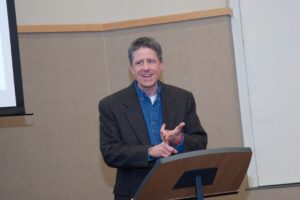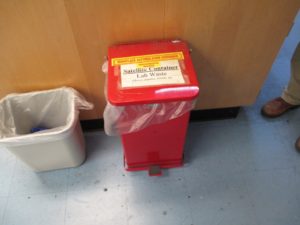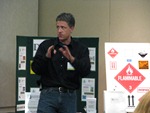Federal regulations of the U.S. Environmental Protection Agency (USEPA) require a small quantity generator of hazardous waste (SQG) to maintain equipment and processes to prevent a hazardous waste emergency and to respond to it if one occurs. The regulations are found in the following SQG conditions for exemption:
- 40 CFR 262.16(b)(8) Preparedness and prevention
- 40 CFR 262.16(b)(9) Emergency procedures
This article is the ninth in a series that closely examines and explains these regulations.
In the previous article in this series I addressed the requirements of 40 CFR 262.16(b)(9)(ii) Post Emergency Response Information at a Small Quantity Generator. That was the second of the Emergency Procedures requirements of §262.16(b)(9). This article addresses the third.
The purpose of this article is to identify and explain: 40 CFR 262.16(b)(9)(iii) Ensure familiarity with emergency procedures at small quantity generator of hazardous waste.
Before we begin…
To me, this requirement is all about training. No, it doesn’t use the word “training. Nor does it specify content or a frequency as it does for the LQG at §262.17(a)(7). But it does require that all employees are thoroughly familiar with how to handle hazardous waste and how to respond to a hazardous waste emergency. That can be done in many ways: signs on the wall, “tailgate meetings”, periodic communication, whatever. But to me, the best way to ensure compliance with §262.16(b)(9)(iii) is formal documented training.
These regulations were revised by the Generator Improvements Rule. If your state has not yet adopted the new rule you must continue to comply with the earlier version until it does. You may read an article explaining the earlier version of the regulations (prior to implementation of the Generator Improvements Rule) here. As noted later in this article, the change made by the Generator Improvements Rule was minor.
After your state adopts the Generator Improvements Rule, it may choose to make its version of these regulations more stringent and more broad than these Federal regulations. The actions of your state will vary based on whether or not it has an authorized hazardous waste program. Be sure to check the regulations of your state to ensure compliance.
Scope and applicability:
The regulations addressed in this article are applicable to a SQG. A large quantity generator of hazardous waste (LQG) has its own distinct requirements for Preparedness, Prevention, and Emergency Procedures. Also, the training requirements for a LQG are more broad and stringent than those of the SQG; they are explicitly stated at 40 CFR 262.17(a)(7).
Not sure of your hazardous waste generator category? |
The placement of these regulations squarely within 40 CFR 262.16 Conditions for exemption for a small quantity generator that accumulates hazardous waste removes any doubt that these regulations apply solely to a SQG.
But where at a SQG? The entire facility? And what operations? Just those related to hazardous waste management? In the preamble to the final rule in the Federal Register, USEPA stated its primary objective was to ensure these regulations do not apply to the entire facility (November 28, 2016, FR 81, 85792). However, USEPA did clarify that these regulations – and all preparedness, prevention, and emergency response procedures of both SQG and LQG – are applicable to all areas of a facility where hazardous waste is:
- Generated. This means all points of generation.
- Accumulated. This includes both central accumulation area(s) (CAA) and satellite accumulation area(s) (SAA).
- Those areas where allowable treatment of hazardous waste may occur in accumulation units (November 28, 2016, FR 81, 85792).
All satellite accumulation areas operated by a small quantity generator must meet the preparedness and prevention regulations of §262.16(b)(8) and emergency procedures of §262.16(b)(9). Prior to the Generator Improvements Rule agency guidance and enforcement limited the applicability of these regulations solely to hazardous waste in the CAA and did not include the SAA. To clarify its position in the preamble, USEPA also added the following to the revised regulations for SAAs at §262.15(a)(7):
All satellite accumulation areas operated by a small quantity generator must meet the preparedness and prevention regulations of §262.16(b)(8) and emergency procedures of §262.16(b)(9).
This is further reinforced by the opening paragraph of §262.16(b)(9), which reads:
The small quantity generator complies with the following conditions for those areas of the generator facility where hazardous waste is generated and accumulated:
Like this article? Subscribe to my Monthly Newsletter No marketing emails! |
But more important than “where” for these regulations is “who”. Who are the “all employees” that are subject to this regulation? That will be addressed later in this article.
40 CFR 262.16(b)(9)(iii) reads:
The small quantity generator must ensure that all employees are thoroughly familiar with proper waste handling and emergency procedures, relevant to their responsibilities during normal facility operations and emergencies;
Why the change?
Not much of a change, really. The opening sentence was revised from “The generator” to “The small quantity generator”. Just another clarification of the applicability of this requirement solely to the SQG. Other than that the regulation remains the same as before the Generator Improvements Rule.
Interested in site specific training at your site that covers this topic, and more! Ask me about my Onsite Training |
What’s the Point?
The SQG must ensure its employees are familiar enough with the applicable regulations so they know how to handle hazardous waste safely and in compliance with the regulations and how to respond to a hazardous waste emergency.
“The small quantity generator must ensure…”
More than just providing the required training and keeping documents as a record for a specified time, the SQG must make certain that its employees are (as we’ll see later in this article) “thoroughly familiar” with how to handle hazardous waste and what to do in an emergency. This is a performance standard that can be checked during a regulatory inspection by an inspector quizzing employees on the shop floor to determine their level of knowledge.
Just how the SQG “ensures” compliance is left up to the SQG. Surely high-quality training is one way.
Contact me with any questions you may have about the generation, identification, management, and disposal of hazardous waste Daniels Training Services, Inc. 815.821.1550 |
“…all employees…”
Who needs training at a SQG?
Taken literally, this would mean every single employee of a SQG. However, this is scaled back to a more manageable number when the following is considered:
- The scope and applicability of the emergency procedures for a SQG – of which this requirement is a part – are limited to areas where hazardous waste are generated, accumulated, or treated; this means the CAA and SAA (see Scope and Applicability earlier in this article). This limits the applicability of SQG training to employees who work in the CAA or SAA.
- EPA noted the personnel of a SQG that require training would be those that handle hazardous waste (RO 11779). This may include activities such as removing hazardous waste containers from a SAA to a CAA and to persons responsible for managing the waste in drums or tanks.
- The SQG’s emergency coordinator identified at §262.16(b)(9)(i) must also receive some form of this training to ensure he/she is thoroughly familiar with their responsibilities in an emergency (RO 11779).
- And, going all the way back to 1986, in the preamble to the SQG rule, USEPA clarified its position that SQG training should only apply to topics germane to an employee’s area(s) of responsibility. The type and amount of training necessary for each employee stems from their specific responsibilities. Employees who work in or adjacent to areas where hazardous waste are generated, handled, or stored but do not handle hazardous waste (e.g., office personnel) must still be trained, but only for basic emergency procedures such as response to fire or spill (training you likely already provided – or should) [51 FR 10165].
- Part-time or temporary employees must also receive appropriate training [51 FR 10165].

I admit to some confusion on the applicability of this training requirement to employees that solely manage hazardous waste in a SAA. Prior to the Generator Improvements Rule it was clear the training requirements for both LQG and SQG did not apply to employees managing hazardous waste solely within the SAA. Even the revised SAA regulations at §262.15(a) exclude both the LQG and SQG from their responsibilities under §262.17 and §262.16, respectively. Which means the normal training requirement doesn’t apply to the SAA. However, as noted above in Scope and Applicability, the Generator Improvements Rule makes the Preparedness, Prevention, and Emergency Procedure regulations for both LQG and SQG applicable to both the CAA and the SAA. For the LQG this doesn’t change anything since their training requirement is found at §262.17(a)(7), and not within the regulations for Preparedness, Prevention, and Emergency Procedures. This is not the case for the training requirement of the SQG which is squarely within the Emergency Procedures of §262.16(b)(9). Also, as noted earlier in this article, §262.15(a)(7) explicitly states the SAA of a SQG must comply with §262.16(b)(9), which brings the SQG back to this training requirement. I believe a SQG should include employees who manage hazardous waste solely within an SAA in this training.
And finally…USEPA believes an assessment of the training requirements for a hazardous waste generator can best be made by an authorized State agency or, if the State does not have an authorized hazardous waste program, the USEPA Regional office (RO 11779). So, check with your state.
“…thoroughly familiar…”
Another vague performance standard without much guidance from USEPA. It is a level of knowledge of the applicable regulations and procedures the SQG has instilled into its employees to the point where they know it well enough to demonstrate that knowledge to others.
- “Thoroughly” is defined at Dictionary.com as: in a thorough manner or degree; completely and carefully or perfectly; utterly.
- “Familiar” is defined at Dictionary.com as: well-acquainted; thoroughly conversant.
Taken together, its clear the SQG should structure its training to not only provide the required content but ensure its employees understand it enough to demonstrate their thorough familiarity with it.
Contact me the next time hazardous waste generator training is due to expire. |
“…with proper waste handling…”
Here we have the only reference to the required content of SQG training. If a person handles hazardous waste he/she should have training to include:
- Proper waste handling and emergency procedures appropriate to the type of waste handled.
- The waste management methods used.
- The hazards presented by the waste type.
- And more depending on the employees normal job responsibilities.
In addition, handlers of hazardous waste and the emergency coordinator(s) identified at §262.16(b)(9)(i) should be trained on the emergency procedures he/she may be required to perform. These are described in §262.16(b)(9)(iv) and include:
- In the event of a fire call the fire department or attempt to extinguish the fire with a fire extinguisher.
- In the event of a spill, contain the flow and clean up the hazardous waste and contaminated materials.
- If a fire, explosion, or other release could threaten human health outside the facility or a spill has reached surface water, immediately notify the National Response Center.
- And more depending on the employees responsibilities in the event of an emergency.
“…relevant to their responsibilities…”
USEPA understands that it makes no sense to require training on topics outside an employee’s normal job responsibilities and/or outside of the SQG’s normal facility operations. That is why the training content, i.e., that which the employee must be “thoroughly familiar” is limited to their usual job function during normal facility operations.
However, training topics must also include employee responsibilities during an emergency. If an employee is part of the facility’s Emergency Response Team, this could be a significant amount of content. It may also simply be that they find the nearest exit and proceed to a safe pre-determined collection point.

A quick Summary:
While not subject to the formal training requirement of the LQG, the SQG is not exempt from all training as is the very small quantity generator (VSQG). Instead, it occupies a middle ground where training is not specifically required, but the desired results of training are: employees that know how to safely manage hazardous waste in compliance with the regulations and know how to respond to an emergency.
Is that it?
No. First of all, as a SQG you must still comply with the remaining requirements of §262.16(b)(9) for emergency procedures and there remains the preparedness and prevention regulations of §262.16(b)(8). You may view all of those regulations here.
The next and final article in this series will address 40 CFR 262.16(b)(9)(iv). It mandates the SQG’s response to specific emergencies.
